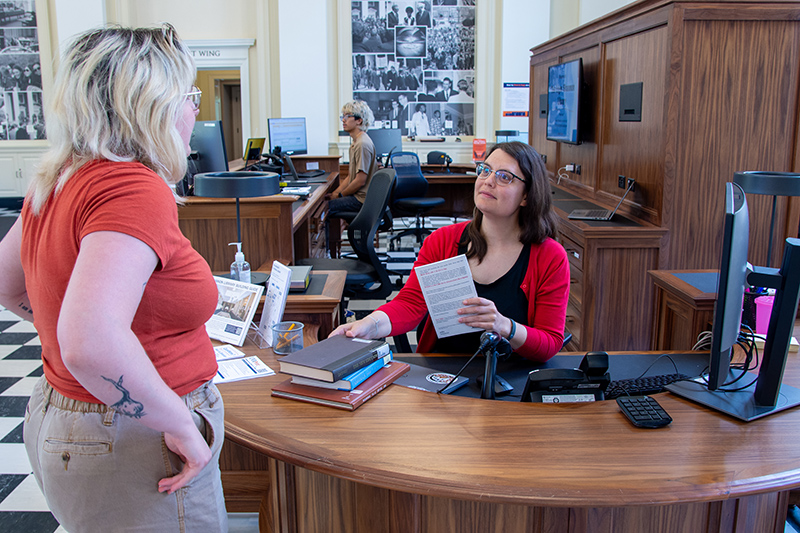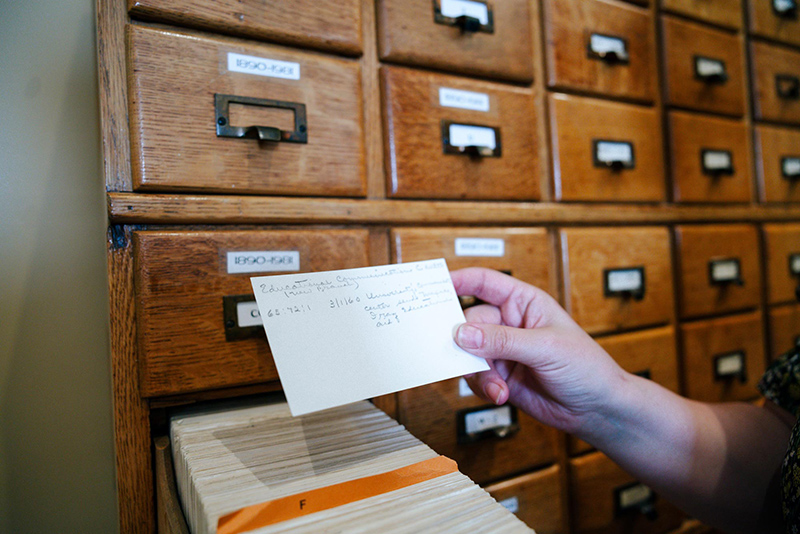UVA Library’s reference team had a busy 2024 as it moved into the renovated Shannon Library and welcomed eager visitors. In April, the month of Shannon’s grand opening to the public, a record-breaking 113,000 people visited the library, and with that surging foot traffic came increased desk inquires for the reference team.
“At UVA Library, reference services are available to any person who walks in our doors or lands on our website,” said Mandy Rizki, one of the three Reference Librarians in Shannon Library. “In the course of a day, all kinds of members of the University community stop by the reference desk, use our online chat, call us on the phone, or send us an email at library@virginia.edu.”
Walk-up reference service is offered in Shannon for all general Library inquiries and in the Albert and Shirley Small Library for specific questions about the unique items in Special Collections.

At Shannon, the reference desk is staffed 10 to 12 hours a day, usually with one of the Reference Librarians on site as well as other Library staff members and graduate student Reference Assistants. The reference team answers an average of 25 queries each day, including emails, chats, phone calls, and walk-up reference questions. The team usually gets nearly 2,000 emails per year and roughly 4,000 online chats per year via the “Ask a Librarian” instant message interface. Reference services are available seven days a week nearly every week of the year.
“Listening in at the desk, you’ll overhear a new graduate student learning to use advanced search tools, a faculty member checking on journal access, an undergraduate discovering our research guides, a community patron learning to navigate the stacks, an international researcher asking about our collections, a local researcher being introduced to our clippings collections, and so much more,” Rizki said.
Last spring, the reference team got some media attention when UVA Today wrote about the Library’s local history clippings collection — 60,000 Charlottesville newspaper clippings of note from the 1930s-90s — which a group of graduate students is working on indexing, as well as the last card catalog in use at UVA, housed in Shannon’s Reference Room and filled with information about issues of the Cavalier Daily and UVA Alumni News from the late 19th century through the early 1990s.

The “last catalog” story in particular was so popular that it was picked up by Radio IQ/WVTF, Southwest Virginia’s largest public radio station. For that piece, Rizki led reporter Sandy Hausman on a tour of the Reference Room using the card catalog — or slip index, as Rizki calls it, “because the things that are in it are actually slips of paper” — as a starting point.
“‘Let’s look up radio,’” [Rizki suggests to Hausman in the article]. “‘I’m going to go to the Rs for the Cavalier Daily and it gives us a whole bunch of dates. I see articles from the 1930s, the 1940s. Let’s start there.’
“The paper slips send her to a neighboring bookshelf where we find back issues of the Cav Daily. They contain quirky clues to student culture over the years.”
In UVA Today, reporter Alice Berry wrote: “The old-fashioned index, hand-written by their predecessors over decades, carries meaning for the current librarians who use it weekly.”
“‘It really makes you feel connected to the work of our field across time’ Rizki said.”
This story originally appeared in the Library’s Annual Report for FY 2023-24. Download the full PDF to read more.
